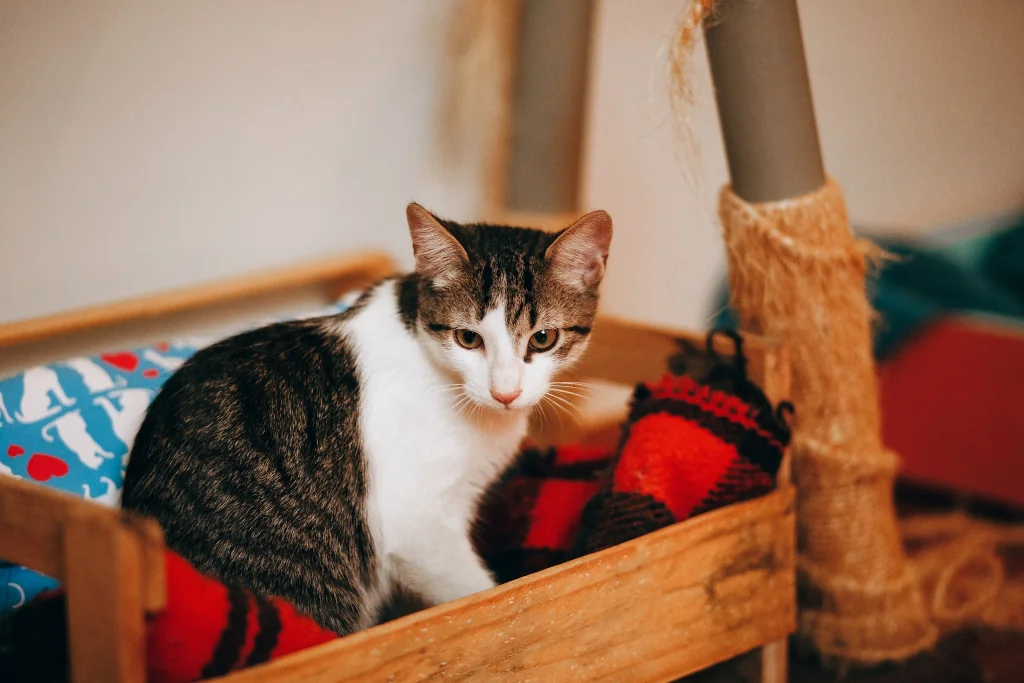Note: We may earn a commission from helpful, relevant links in our content. No cost to you. See our privacy policy.
Getting ready to welcome a new feline into your home? We know it can be both exciting and nerve-racking to prepare for their arrival.
A well-prepared home for a new cat is one that is safe, comfortable, and cat-friendly. From securing potential hazards to arranging amenities like food, water, and litter boxes, proper preparation can ensure your new pet feels at home right away.
In this post, we’ll cover some key steps to follow. With these simple but effective measures, you can transform your home into a feline paradise.

What Does a Cat-Friendly Home Look Like?
First things first, a cat-friendly home is one that respects a cat’s instinctive needs while providing a safe and engaging environment.
Think along the lines of cozy hideaway spots for their privacy, scratchable surfaces for their natural clawing instinct, and vertical spaces like cat towers or wall shelves, as our feline friends love exploring heights.
Remember, it’s about blending safety and enrichment to meet their physical and psychological needs.
Choosing the Perfect Spots for Food and Water
Just as important as creating a welcoming space is selecting the right locations for your cat’s food and water bowls.
Cats prefer to eat and drink in quiet, low-traffic areas where they won’t be disturbed. Additionally, contrary to what many believe, it’s best to separate their water and food bowls.
Cats instinctively like their water to be away from their food – an instinct dating back to their ancestors who wouldn’t drink water near their kill for fear of contamination.
Try experimenting with a few spots until your cat shows a clear preference.
Litter Box Placement: The Do’s and Don’ts
When it comes to setting up your cat’s litter box, the placement is key. Here are some essential do’s and don’ts to keep in mind:
Do’s
- Place in low-traffic areas. Your cat needs privacy while doing its business, just like humans do. Therefore, keep the litter box in a spot where there’s minimal disturbance.
- Ensure easy access. If you have multiple floors in your home, it’s advisable to have a litter box on each floor. This ensures your cat always has easy access to a litter box.
- Have an extra litter box. As a rule of thumb, the number of litter boxes should be one more than the number of cats. This strategy minimizes the chance of any unpleasant ‘surprises’ around your house. We’ve covered all this in our blog post on choosing the right litter box and litter for your cat.
Don’ts
- Avoid food and water zones. Cats instinctively don’t like to eliminate where they eat. To avoid litter box issues, ensure to set up the litter box away from their food and water bowls.
- Don’t corner the box. Cats prefer not to feel cornered while using their litter box. Avoid tucking it away in a tight corner or enclosed area.
Remember, comfort is key for your cat when it comes to using a litter box. Keep these tips in mind, and you’ll create a litter box environment that your cat feels comfortable using, making your journey as a cat owner a smoother one.
If you’re still having problems, consider training your new adult cat to use the litter box. We have a guide for kittens, too!
Essential Amenities: Toys, Beds, and More
Cats love scratching posts or pads, which not only cater to their instinct to scratch but also save your furniture from potential destruction.
Beds should be soft and cozy; heated beds are an excellent choice, especially for colder months.
Investing in interactive toys, such as puzzle feeders, helps to keep your cat mentally stimulated.
Having a range of toys can mimic the hunting experience, satisfying their natural predatory instincts. Get your cat one of these hunting toys for enrichment, and she’ll thank you.
Don’t forget a grooming brush suitable for your cat’s coat length, which not only keeps their fur in check but also enhances bonding time between you two. You can choose between a slicker brush, or a bristle brush, depending on your cat’s coat. Our cat grooming guide has more info.
But don’t forget, the most cherished plaything to your cat might just be that simple cardboard box left over from your last online shopping spree! Who knew preparing for a cat could be an invitation to embrace simplicity? Other times, a complex cardboard box with holes might be better:
These essentials help create an environment where your cat can follow their natural behavior patterns, ensuring they’re content and stimulated.
Cat-Proofing: Securing Your Home for Safety
We’ve spoken about creating a cat-friendly home, but there’s another side to this coin.
Imagine this: your adventurous little furball leaps onto the kitchen counter, only to be greeted by a bouquet of lilies, toxic to cats. Or what about that intriguing loose wire? A nibble there could lead to a nasty shock. Let’s not even consider the heart-stopping horror of a high window with a faulty screen.
The truth is, your home is filled with hazards you’ve never considered because you’ve never looked at it through a cat’s eyes.
It’s not just about hiding the breakables; it’s about transforming your home into a safe haven where your curious kitty can explore to its heart’s content.
A friend of mine once scoffed at my warning about the danger of window screens. That was until my cat, Smokey, managed to push through one and gave us all a heart attack. Thankfully, he only ended up on the porch, but that could have been a catastrophe.
So, while we’re enjoying the excitement of welcoming a new pet, let’s not forget to see our homes from their perspective—it might just save us from the unexpected.
In my next posts, we’ll go into gradually introducing your cat to your new home, as well as helping your new cat establish their territory. This will create a secure, safe, and stimulating environment for our feline friends. Stay tuned!
FAQs
What items should I buy before bringing a new cat home?
To welcome a new cat, you’ll need essentials like a litter box, cat litter, food and water bowls, a bed, grooming supplies, toys for mental stimulation, and cat-friendly food.
How can I make my home safe for a new cat?
Making your home safe involves cat-proofing potential hazards, like toxic plants and chemicals, securing loose cords, covering sharp furniture edges, and ensuring windows and doors are secure.
Should I prepare a specific room for the new cat initially?
Yes, preparing a specific room initially can help the new cat feel secure and adjust slowly to their new surroundings. Gradually, they can be introduced to other parts of the home.
Is it necessary to childproof my home for a new cat?
While you don’t need to childproof your home for a new cat, some similar measures like securing loose cords, removing small ingestible items, and covering sharp edges can help keep them safe.
Alex, a passionate animal lover, has experience in training and understanding animal behavior. As a proud pet parent to two dogs and three cats, he founded AnimalReport.net to share insights from animal experts and expand his knowledge of the animal kingdom.









